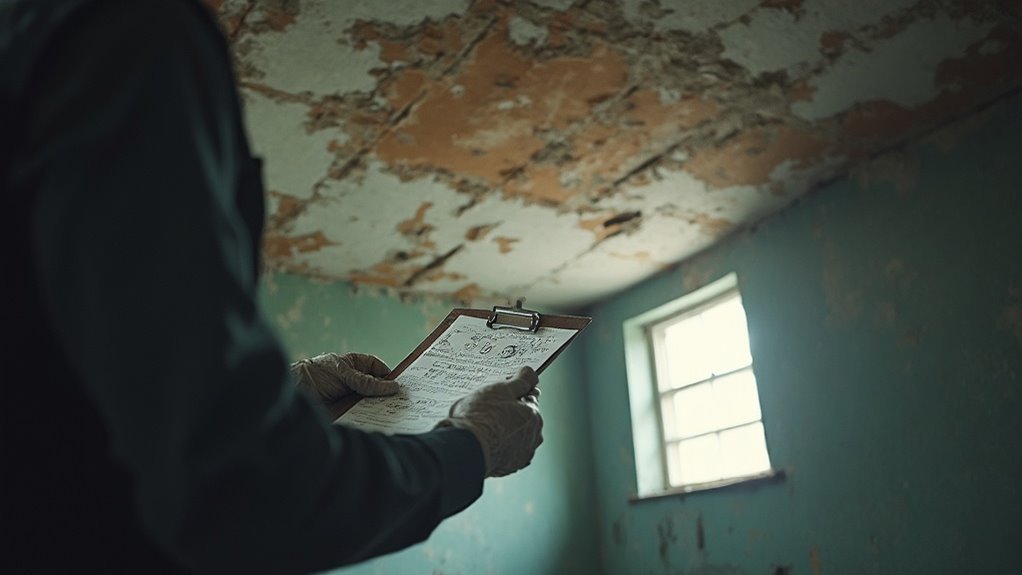Asbestos exposure can lead to severe health issues like lung cancer and mesothelioma, making regular inspections essential for your safety. You might unknowingly encounter asbestos fibers during renovations, construction, or even from colleagues who've worked with it. Inspections help identify asbestos-containing materials (ACMs), ensuring compliance with safety regulations and protecting your health. They can prevent dangerous airborne exposure and significant legal repercussions. Ignoring asbestos can increase your risk of serious disease and incur hefty remediation costs. If you want to understand the various types of inspections and their benefits, there's much more to uncover.
Health Risks of Asbestos

Asbestos exposure poses essential health risks that can lead to severe diseases like lung cancer, asbestosis, and mesothelioma. When you inhale asbestos fibers, they can cause inflammation and scarring in your lungs, which may eventually result in cancer. Notably, no amount of asbestos exposure is considered safe; even minimal exposure increases your risk of developing asbestos diseases. The likelihood of serious health issues escalates with the duration and intensity of exposure. All asbestos fibers are harmful if breathed, underscoring the importance of prevention.
Regular asbestos testing is essential for identifying potential risks in older buildings. Asbestosis, characterized by lung tissue scarring, can manifest long after the initial exposure. Mesothelioma, a particularly aggressive cancer of the lung lining, often doesn't appear until 20 to 50 years post-exposure. Early signs might include vague symptoms such as coughing or shortness of breath, easily mistaken for less severe ailments.
Statistics reveal that nearly 1,300 Americans die from asbestos-related diseases each year, with millions still exposed in various workplaces. To protect yourself, understanding the risks and implementing exposure prevention strategies is vital. Awareness and timely interventions can greatly reduce your chances of developing these life-threatening conditions.
Sources of Asbestos Exposure
While many people might associate asbestos exposure primarily with specific industries, the reality is that it can come from a variety of sources. Understanding these sources is essential for exposure prevention. Asbestos can be found in mining, manufacturing, construction, and even in your home. Here are some key sources to take into account:
| Source of Exposure | Description | Risk Level |
|---|---|---|
| Mining and Processing | Direct exposure in mines and processing facilities | High |
| Construction and Demolition | Asbestos released during renovations and repairs | High |
| Secondary Exposure | Workers sharing spaces with asbestos handlers | Moderate |
| Natural Occurrence | Asbestos in rock and soil, especially in certain areas | Variable |
| Home Renovation | Disturbance of asbestos during DIY projects | High |
Asbestos regulations have been put in place to help mitigate these risks, but awareness is key. If you're in an industry where exposure is a concern, take proactive measures. Stay updated about regulations, and prioritize safety practices to protect yourself and your loved ones. By understanding these sources, you can make knowledgeable choices to minimize your risk of asbestos exposure. Additionally, asbestos exposure can lead to severe diseases, making it vital to remain vigilant in identifying potential risks.
Importance of Inspections

Understanding the potential sources of asbestos exposure is only the first step in guaranteeing safety. Regular inspections are vital, as they comply with federal regulations mandated by OSHA and the US EPA. These inspections not only identify and manage risks but likewise protect occupants' health and guarantee legal compliance. The inspection benefits extend beyond compliance; they help you avoid unexpected costs and delays during renovation or demolition projects by guiding proper remediation actions.
You should consider inspection frequency based on your building's age, condition of asbestos materials, and usage patterns. Older buildings, particularly those constructed before 2000, are more likely to contain hazardous materials, necessitating regular surveys. If you plan any renovation or demolition activities, conducting pre-remodeling inspections is key to prevent airborne asbestos fibers, which pose serious health risks.
Moreover, maintaining an updated asbestos register is fundamental for sustaining a safe environment. Inspections not only guarantee compliance with regulations but likewise improve air quality by identifying harmful fibers that need removal or encapsulation. Ultimately, regular inspections protect the health of residents, guests, and contractors alike.
Types of Asbestos Surveys
How can you ascertain the safety of your environment when dealing with potential asbestos-containing materials (ACMs)? One effective way is through various types of asbestos surveys. Understanding these surveys helps you comply with asbestos regulations and secure a safe space.
Here's a breakdown of the common types of asbestos surveys:
| Survey Type | Objective |
|---|---|
| Asbestos Management Survey | Identify and assess ACMs during normal occupancy. |
| Asbestos Refurbishment Survey | Locate ACMs in areas set for refurbishment. |
| Asbestos Demolition Survey | Identify all ACMs before demolition activities. |
| Sampling and Risk Assessment | Collect samples for lab analysis and assess potential risks. |
Survey techniques include visual inspections, sampling strategies, and laboratory analysis using methods like PLM, TEM, SEM, and XRD. Each technique serves a purpose, whether it's locating ACMs or confirming their presence. By conducting these surveys, you not only comply with established asbestos regulations but likewise protect yourself and others from the hidden dangers associated with asbestos exposure. Prioritize safety through thorough inspections and thoughtful decision-making.
Consequences of Ignoring Asbestos

Neglecting asbestos can frequently lead to severe health, legal, and financial consequences. When you ignore asbestos, you expose yourself and others to increased risks of serious diseases like mesothelioma and lung cancer, which can take decades to manifest. With around 5,000 deaths annually in the UK attributed to asbestos-related illnesses, the stakes are high.
Legally, non-compliance with asbestos regulations can result in hefty fines, potential imprisonment, and significant legal liabilities. If employees or residents suffer as a result of asbestos exposure, you could face lawsuits that lead to substantial financial settlements and legal fees. Furthermore, non-compliance can jeopardize contracts, increasing project costs and damaging your reputation.
From a financial standpoint, the costs of remediation can be astronomical. You may face business interruptions as a result of enforcement actions, leading to lost revenue and higher insurance premiums. Ignoring asbestos puts your organization at risk of long-term financial liabilities that can cripple your operations. To safeguard health and finances, it's essential to conduct regular asbestos inspections and adhere strictly to regulations, ensuring a safer environment for everyone involved.
Frequently Asked Questions
How Can I Tell if My Home Contains Asbestos?
To determine if your home contains asbestos, use asbestos testing methods like air sampling or hire a professional inspector. Recognizing potential health risks is essential, especially in older homes built before the 1970s.
What Should I Do if I Find Asbestos?
If you find asbestos, don't disturb it. Contact licensed professionals for asbestos removal to mitigate health risks. They'll safely seal off the area, ensuring minimal exposure and compliance with regulations throughout the removal process.
Are Asbestos Inspections Expensive?
Asbestos testing costs average around $495, but can vary considerably. Investing in professional inspections provides essential benefits, including health risk assessments and regulatory compliance, ensuring your safety and long-term peace of mind during renovations.
How Often Should I Conduct an Asbestos Inspection?
You should conduct an asbestos inspection every 6-12 months, depending on building age and condition. Adhering to asbestos regulations guarantees proper inspection frequency, maintaining safety, compliance, and effective management of asbestos-containing materials.
Can I Perform an Asbestos Inspection Myself?
Sure, you can attempt DIY inspections, but without professional training, you're playing with fire. Asbestos testing requires expertise; incorrect handling can expose you and others to serious health risks. Don't take that chance!
